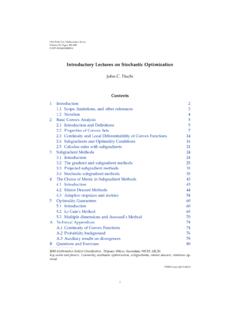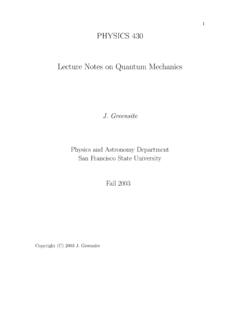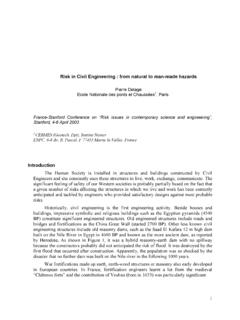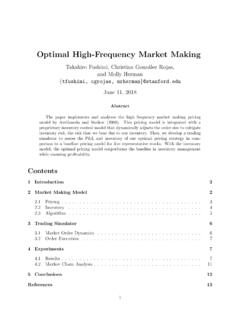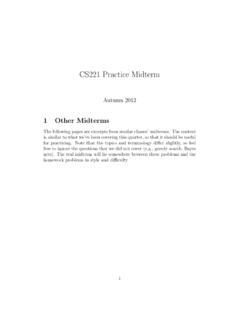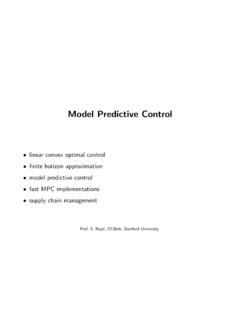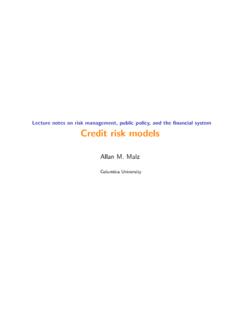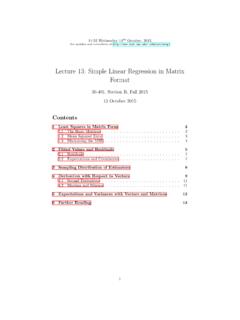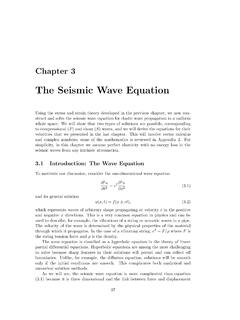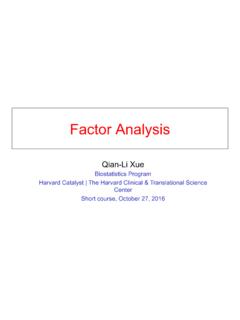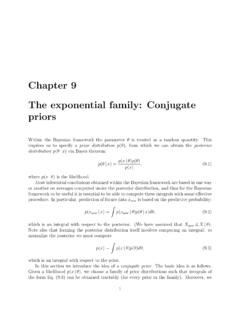Transcription of Lecture 17 Perron-Frobenius Theory - Stanford University
1 EE363 Winter 2008-09 Lecture 17 Perron-Frobenius Theory Positive and nonnegative matrices and vectors Perron-Frobenius theorems Markov chains Economic growth Population dynamics Max-min and min-max characterization Power control Linear Lyapunov functions Metzler matrices17 1 Positive and nonnegative vectors and matriceswe say a matrix or vector is positive(orelementwise positive) if all its entries are positive nonnegative(orelementwise nonnegative) if all its entries arenonnegativewe use the notationx > y(x y) to meanx yis elementwise positive(nonnegative)warning:ifAandBare square and symmetric,A Bcan mean: A Bis PSD ( ,zTAz zTBzfor allz), or A Belementwise positive ( ,Aij Bijfor alli, j)in this Lecture ,>and mean elementwisePerron- frobenius Theory17 2 Application areasnonnegative matrices arise in many fields, , economics population models graph Theory Markov chains power control in communications Lyapunov analysis of large scale systemsPerron- frobenius Theory17 3 Basic factsifA 0andz 0, then we haveAz 0conversely.
2 If for allz 0, we haveAz 0, then we can concludeA 0in other words, matrix multiplication preserves nonnegativity if and only ifthe matrix is nonnegativeifA >0andz 0,z6= 0, thenAz >0conversely, if wheneverz 0,z6= 0, we haveAz >0, then we canconcludeA >0ifx 0andx6= 0, we refer tod= (1/1Tx)xas itsdistributionornormalized formdi=xi/(Pjxj)gives the fraction of the total ofx, given byxiPerron- frobenius Theory17 4 Regular nonnegative matricessupposeA Rn n, withA 0 Ais calledregularif for somek 1,Ak>0meaning:form directed graph on nodes1, .. , n, with an arc fromjtoiwheneverAij>0then(Ak)ij>0if and only if there is a path of lengthkfromjtoiAis regular if for somekthere is a path of lengthkfrom every node toevery other nodePerron- frobenius Theory17 5examples.
3 Any positive matrix is regular 1 10 1 and 0 11 0 are not regular 1 1 00 0 11 0 0 is regularPerron- frobenius Theory17 6 Perron-Frobenius theorem for regular matricessupposeA Rn nis nonnegative and regular, ,Ak>0for somekthen there is an eigenvalue pfofAthat is real and positive, with positiveleft and right eigenvectors for any other eigenvalue , we have| |< pf the eigenvalue pfis simple, , has multiplicity one, and correspondsto a1 1 Jordan blockthe eigenvalue pfis called thePerron- frobenius (PF) eigenvalue ofAthe associated positive (left and right) eigenvectors are calledthe (left andright) PF eigenvectors (and are unique, up to positive scaling) Perron-Frobenius Theory17 7 Perron-Frobenius theorem for nonnegative matricessupposeA Rn nandA 0then there is an eigenvalue pfofAthat is real and nonnegative, withassociated nonnegative left and right eigenvectors for any other eigenvalue ofA, we have| | pf pfis called thePerron- frobenius (PF) eigenvalue ofAthe associated nonnegative (left and right)
4 Eigenvectors are called (left andright) PF eigenvectorsin this case, they need not be unique, or positivePerron- frobenius Theory17 8 Markov chainswe consider stochastic processX0, X1, ..with values in{1, .. , n}Prob(Xt+1=i|Xt=j) =PijPis called thetransition matrix; clearlyPij 0letpt Rnbe the distribution ofXt, ,(pt)i=Prob(Xt=i)then we havept+1=P ptnote:standard notation uses transpose ofP, and row vectors forprobability distributionsPis astochastic matrix, ,P 0and1TP=1 Tso1is a left eigenvector with eigenvalue1, which is in fact the PFeigenvalue ofPPerron- frobenius Theory17 9 Equilibrium distributionlet denote a PF (right) eigenvector ofP, with 0and1T = 1sinceP = , corresponds to aninvariant distributionorequilibriumdistributionof the Markov chainnow supposePis regular, which means for somek,Pk>0since(Pk)ijisProb(Xt+k=i|Xt=j)
5 , this means there is positiveprobability of transitioning from any state to any other inkstepssincePis regular, there is a unique invariant distribution , which satisfies >0the eigenvalue1is simple and dominant, so we havept , no matterwhat the initial distributionp0in other words: the distribution of a regular Markov chain alwaysconvergesto the unique invariant distributionPerron- frobenius Theory17 10 Rate of convergence to equilibrium distributionrate of convergence to equilibrium distribution depends on second largesteigenvalue magnitude, , = max{| 2|.}
6 ,| n|}where iare the eigenvalues ofP, and 1= pf= 1( is sometimes called the SLEM of the Markov chain)themixing timeof the Markov chain is given byT=1log(1/ )(roughly, number of steps over which deviation from equilibriumdistribution decreases by factore) Perron-Frobenius Theory17 11 Dynamic interpretationconsiderxt+1=Axt, withA 0and regularthen by PF theorem, pfis the unique dominant eigenvalueletv, w >0be the right and left PF eigenvectors ofA, with1Tv= 1,wTv= 1then ast ,( 1pfA)t vwTfor anyx0 0,x06= 0, we have11 Txtxt vast , , the distribution ofxtconverges tovwe also have(xt+1)i/(xt)i pf, , the one-period growth factor ineach component always converges to pfPerron- frobenius Theory17 12 Economic growthwe consider an economy, with activity levelxi 0in sectori,i= 1.
7 , ngiven activity levelxin periodt, in periodt+ 1we havext+1=Axt, withA 0 Aij 0means activity in sectorjdoes not decrease activity in sectori, , the activities are mutually noninhibitorywe ll assume thatAis regular, with PF eigenvalue pf, and left and rightPF eigenvectorsw, v, with1Tv= 1,wTv= 1PF theorem tells us: (xt+1)i/(xt)i, the growth factor in sectoriover the period fromttot+ 1, each converge to pfast the distribution of economic activity ( ,xnormalized) converges tovPerron- frobenius Theory17 13 asymptotically the economy exhibits (almost) balanced growth, bythefactor pf, in each sectorthese hold independent of the original economic activity, provided it isnonnegative and nonzerowhat does left PF eigenvectorwmean?
8 For largetwe havext tpfwTx0vwhere means we have dropped terms small compared to dominant termso asymptotic economic activity is scaled bywTx0in particular,wigives the relativevalueof activityiin terms of long termeconomic activityPerron- frobenius Theory17 14 Population model(xt)idenotes number of individuals in groupiat periodtgroups could be by age, location, health, marital status, dynamics is given byxt+1=Axt, withA 0 Aijgives the fraction of members of groupjthat move to groupi, or thenumber of members in groupicreated by members of groupj( , inbirths)Aij 0means the more we have in groupjin a period, the more we havein groupiin the next period ifPiAij= 1, population is preserved in transitions out of groupj we can havePiAij>1, if there are births (say)
9 From members ofgroupj we can havePiAij<1, if there are deaths or attrition in groupjPerron- frobenius Theory17 15now supposeAis regular PF eigenvectorvgives asymptotic population distribution PF eigenvalue pfgives asymptotic growth rate (if>1) or decay rate(if<1) wTx0scales asymptotic population, sowigives relative value of initialgroupito long term populationPerron- frobenius Theory17 16 Path count in directed graphwe have directed graph onnnodes, with adjacency matrixA Rn nAij= 1there is an edge from nodejto nodei0otherwise Ak ijis number of paths fromjtoiof lengthknow supposeAis regularthen for largek,Ak kpfvwT= kpf(1Tw)v(w/1Tw)T( means: keep only dominant term)v, ware right, left PF eigenvectors, normalized as1Tv= 1,wTv= 1 Perron-Frobenius Theory17 17total number of paths of lengthk.
10 1 TAk1 kpf(1Tw)forklarge, we have (approximately) pfis factor of increase in number of paths when length increases byone vi: fraction of lengthkpaths that end ati wj/1Tw: fraction of lengthkpaths that start atj viwj/1Tw: fraction of lengthkpaths that start atj, end ati vimeasures importance/connectedness of nodeias asink wj/1 Twmeasures importance/connectedness of nodejas asourcePerron- frobenius Theory17 18(Part of) proof of PF theorem for positive matricessupposeA >0, and consider the optimization problemmaximize subject toAx xfor somex 0, x6= 0note that we can assume1Tx= 1interpretation.
